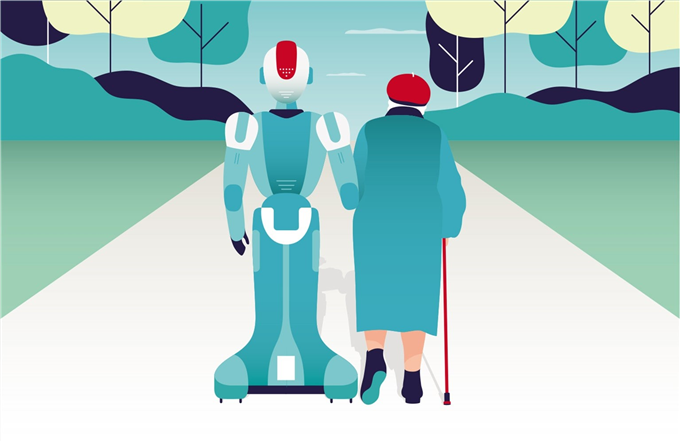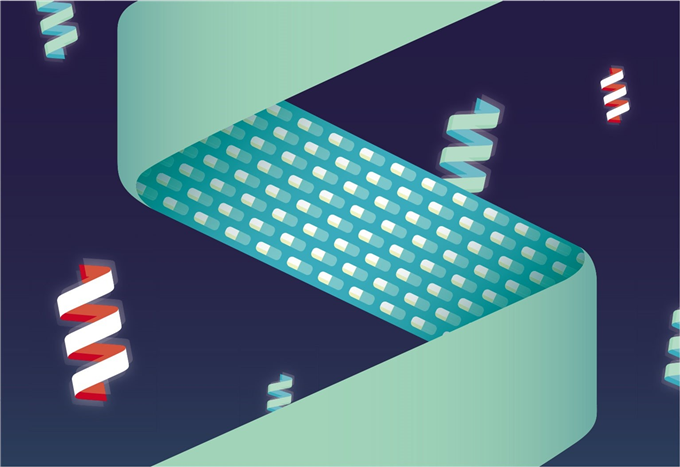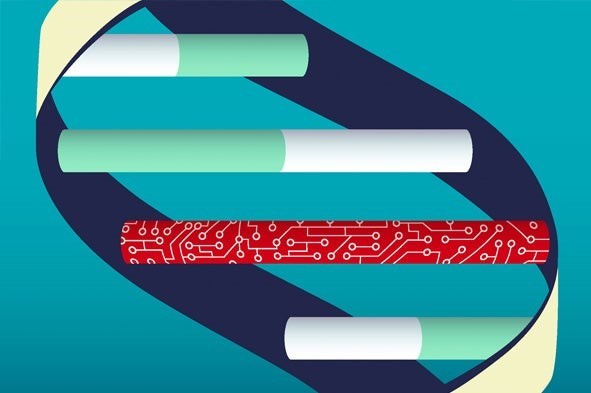Credit: Vanessa Branchi
Top 10 Emerging Technologies Of 2019
World-changing technologies that are poised to rattle the status quo
facebook
December 1, 2019
One day soon an emerging technology highlighted in this report will allow you to virtually teleport to a distant site and actually feel the handshakes and hugs of fellow cyber travelers. Also close to becoming commonplace: humanoid (and animaloid) robots designed to socialize with people; a system for pinpointing the source of a food-poisoning outbreak in just seconds; minuscule lenses that will pave the way for diminutive cameras and other devices; strong, biodegradable plastics that can be fashioned from otherwise useless plant wastes; DNA-based data-storage systems that will reliably stow ginormous amounts of information; and more.
Together with the World Economic Forum, Scientific American convened an international Steering Group of leading technology experts and engaged in an intense process to identify this year's “Top 10 Emerging Technologies.” After soliciting nominations from additional experts around the globe, the Steering Group evaluated dozens of proposals according to a number of criteria: Do the suggested technologies have the potential to provide major benefits to societies and economies? Could they alter established ways of doing things? Are they still in early stages of development but attracting a lot of interest from research labs, companies or investors? Are they likely to make significant inroads in the next several years? The group sought more information where needed and honed the list in four virtual meetings.
We hope you enjoy the result, and we welcome your responses.
1 ENVIRONMENT : BIOPLASTICS COULD SOLVE A MAJOR POLLUTION PROBLEM
Advanced solvents and enzymes are transforming woody wastes into better biodegradable plastics
BY JAVIER GARCIA MARTINEZ
 Our civilization is built on plastics. In 2014 alone, industry generated 311 million metric tons, an amount expected to triple by 2050, according to the World Economic Forum. Yet less than 15 percent of it gets recycled. Much of the rest is incinerated, sits in landfills or is abandoned in the environment—where, being resistant to microbial digestion, it can persist for hundreds of years. Plastic debris accumulating in the ocean causes all kinds of problems, from killing wildlife when mistakenly ingested to releasing toxic compounds. It can even enter our bodies via contaminated fish.
Our civilization is built on plastics. In 2014 alone, industry generated 311 million metric tons, an amount expected to triple by 2050, according to the World Economic Forum. Yet less than 15 percent of it gets recycled. Much of the rest is incinerated, sits in landfills or is abandoned in the environment—where, being resistant to microbial digestion, it can persist for hundreds of years. Plastic debris accumulating in the ocean causes all kinds of problems, from killing wildlife when mistakenly ingested to releasing toxic compounds. It can even enter our bodies via contaminated fish.
Biodegradable plastics can ease these problems, contributing to the goal of a “circular” plastic economy in which plastics derive from and are converted back to biomass. Like standard plastics derived from petrochemicals, biodegradable versions consist of polymers (long-chain molecules) that can be molded while in their fluid state into a variety of forms. The options currently available—mostly made from corn, sugarcane, or waste fats and oils—generally lack the mechanical strength and visual characteristics of the standard kinds, however. Recent breakthroughs in producing plastics from cellulose or lignin (the dry matter in plants) promise to overcome those drawbacks. In an added boon for the environment, cellulose and lignin can be obtained from nonfood plants, such as giant reed, grown on marginal land not suitable for food crops or from waste wood and agricultural by-products that would otherwise serve no function.
Cellulose, the most abundant organic polymer on earth, is a major component of plant cell walls; lignin fills the spaces in those walls, providing strength and rigidity. To make plastics from those substances, manufacturers must first break them into their building blocks, or monomers. Investigators have recently found ways to do so for both substances. The lignin work is particularly important because lignin's monomers are composed of aromatic rings—the chemical structures that give some standard plastics their mechanical strength and other desirable features. Lignin does not dissolve in most solvents, but investigators have shown that certain environmentally friendly ionic liquids (which are composed largely of ions) can selectively separate it from wood and woody plants. Genetically engineered enzymes similar to those in fungi and bacteria can then break the dissolved lignin into its components.
Companies are building on these findings. For example, Chrysalix Technologies, a spin-off from Imperial College London, has developed a process that uses low-cost ionic liquids to separate cellulose and lignin from starting materials. A Finnish biotechnology company, MetGen Oy, produces a number of genetically engineered enzymes that cleave lignins of different origins into components needed for a wide range of applications. And Mobius (formerly Grow Bioplastics) is developing lignin-based plastic pellets for use in biodegradable flower pots, agricultural mulches and other products.
Many hurdles must be overcome before the new plastics can be widely used. One is cost. Another is minimizing the amount of land and water used to produce them—even if the lignin comes only from waste, water is needed to convert it into plastic. As with any major challenge, the solutions will require a combination of measures, from regulations to voluntary changes in the ways society uses and disposes of plastics. Still, the emerging methods for producing biodegradable plastic offer a perfect example of how greener solvents and more effective biocatalysts can contribute to generating a circular economy in a major industry.
2 ENGINEERING : SOCIAL ROBOTS PLAY NICELY WITH OTHERS
Droid friends and assistants are penetrating deeper into our lives
BY CORINNA E. LATHAN AND GEOFFREY LING
In industry and medicine, robots routinely build, break down and inspect things; they also assist in surgery and dispense prescription drugs in pharmacies. Neither they nor “social” robots—which are designed to engage with people and to elicit an emotional connection—behave like The Jetsons'maid, Rosie, or other beloved droids of fiction. Even so, expect social robots to become more sophisticated and prevalent in the next few years. The field seems to have reached a tipping point, with bots having greater interactive capabilities and performing more useful tasks than ever before.
 Like most robots, social robots use artificial intelligence to decide how to act on information received through cameras and other sensors. The ability to respond in ways that seem lifelike has been informed by research into such issues as how perceptions form, what constitutes social and emotional intelligence, and how people can deduce others' thoughts and feelings. Advances in AI have enabled designers to translate such psychological and neuroscientific insights into algorithms that allow robots to recognize voices, faces and emotions; interpret speech and gestures; respond appropriately to complex verbal and nonverbal cues; make eye contact; speak conversationally; and adapt to people's needs by learning from feedback, rewards and criticisms.
Like most robots, social robots use artificial intelligence to decide how to act on information received through cameras and other sensors. The ability to respond in ways that seem lifelike has been informed by research into such issues as how perceptions form, what constitutes social and emotional intelligence, and how people can deduce others' thoughts and feelings. Advances in AI have enabled designers to translate such psychological and neuroscientific insights into algorithms that allow robots to recognize voices, faces and emotions; interpret speech and gestures; respond appropriately to complex verbal and nonverbal cues; make eye contact; speak conversationally; and adapt to people's needs by learning from feedback, rewards and criticisms.
In consequence, social robots are filling an ever expanding variety of roles. A 47-inch humanoid called Pepper (from SoftBank Robotics), for instance, recognizes faces and basic human emotions and engages in conversations via a touch screen in its “chest.” About 15,000 Peppers worldwide perform such services as hotel check-ins, airport customer service, shopping assistance and fast-food checkout. Temi (from Temi USA) and Loomo (Segway Robotics) are the next generation of personal assistants—like Amazon Echo and Google Home but mobile, providing a new level of functionality. Loomo, for instance, not only is a companion but also can transform on command into a scooter for transport.
Social robots have particular appeal for assisting the world's growing elderly population. The PARO Therapeutic Robot (developed by Japan's National Institute of Advanced Industrial Science and Technology), which looks like a cuddly seal, is meant to stimulate and reduce stress for those with Alzheimer's disease and other patients in care facilities: it responds to its name by moving its head, and it cries for petting. Mabu (Catalia Health) engages patients, particularly the elderly, as a wellness aide, reminding them to take walks and medication and to call family members. Social robots are also gaining traction with consumers as toys. Early attempts to incorporate social behavior in toys, such as Hasbro's Baby Alive and Sony's AIBO robotic dog, had limited success. But both are resurging, and the most recent version of AIBO has sophisticated voice and gesture recognition, can be taught tricks and develops new behaviors based on previous interactions.
Worldwide sales of consumer robots reached an estimated $5.6 billion in 2018, and the market is expected to grow to $19 billion by the end of 2025, with more than 65 million robots sold a year. This trend may seem surprising given that multiple well-funded consumer robot companies, such as Jibo and Anki, have failed. But a wave of robots is lining up to take the place of defunct robots, including BUDDY (Blue Frog Robotics), a big-eyed mobile device that plays games in addition to acting as a personal assistant and providing home automation and security.
3 ENGINEERING : TINY LENSES WILL ENABLE DESIGN OF MINIATURE OPTICAL DEVICES
Thin, flat metalenses could replace bulky glass for manipulating light
BY ALBERTO MOSCATELLI
As phones, computers and other electronics have grown ever smaller, their optical components have stubbornly refused to shrink. Notably, it is hard to make tiny lenses with traditional glass-cutting and glass-curving techniques, and the elements in a glass lens often need to be stacked to focus light properly. Engineers have recently figured out much of the physics behind much smaller, lighter alternatives known as metalenses. These lenses could allow for greater miniaturization of microscopes and other laboratory tools, as well as of consumer products, such as cameras, virtual-reality headsets and optical sensors for the Internet of Things. And they could enhance the functionality of optical fibers.
A metalens consists of a flat surface, thinner than a micron, that is covered with an array of nanoscale objects, such as jutting pillars or drilled holes. As incident light hits these elements, many of its properties change—including its polarization, intensity, phase and direction of propagation. Researchers can precisely position the nanoscale objects to ensure that the light that exits the metalens has selected characteristics. What is more, metalenses are so thin that several can sit atop one another without a significant increase in size. Researchers have demonstrated optical devices such as spectrometers and polarimeters made from stacks of these flat surfaces.
 In a major breakthrough last year, researchers solved a problem called chromatic aberration. As white light passes through a typical lens, rays of its varied wavelengths get deflected at different angles and thus focus at different distances from the lens; to fix this effect, engineers today need to layer lenses in a finicky alignment. Now a single metalens can focus all the wavelengths of white light onto the same spot. Beyond creating this “achromatic” metalens, scientists have developed metalenses that correct other aberrations, such as coma and astigmatism, which cause image distortions and blurring.
In a major breakthrough last year, researchers solved a problem called chromatic aberration. As white light passes through a typical lens, rays of its varied wavelengths get deflected at different angles and thus focus at different distances from the lens; to fix this effect, engineers today need to layer lenses in a finicky alignment. Now a single metalens can focus all the wavelengths of white light onto the same spot. Beyond creating this “achromatic” metalens, scientists have developed metalenses that correct other aberrations, such as coma and astigmatism, which cause image distortions and blurring.
In addition to reducing size, metalenses should ultimately lower the cost of optical components because the diminutive lenses can be manufactured with the same equipment already used in the semiconductor industry. This feature raises the alluring prospect of fabricating, say, a tiny light sensor's optical and electronic components side by side.
For now, however, expenses are still high because it is difficult to precisely place nanoscale elements on a centimeter-scale chip. Other limitations also need addressing. So far metalenses do not transmit light as efficiently as traditional lenses do—an important capability for such applications as full-color imaging. In addition, they are too small to capture a large quantity of light, which means that, at least for now, they are not suited to snapping high-quality photographs.
Nevertheless, in the next few years the tiny lenses will probably make their way into smaller, easier-to-manufacture sensors, diagnostic tools such as endoscopic imaging devices, and optical fibers. Those potential applications are appealing enough to have attracted research support from government agencies and such companies as Samsung and Google. At least one start-up, Metalenz, expects to bring metalenses to market within the next few years.
4 MEDICAL & BIOTECH : A SPECIAL CLASS OF PROTEINS OFFERS PROMISING TARGETS FOR DRUGS FOR CANCER AND ALZHEIMER’S
New possibilities for treating cancer and other ills
BY ELIZABETH O’DAY
 Decades ago scientists identified a particular class of proteins driving illnesses from cancer to neurodegenerative disease. These “intrinsically disordered proteins” (IDPs) looked different from the proteins with rigid structures that were more familiar in cells. IDPs were shape-shifters, appearing as ensembles of components that constantly changed configurations. This loose structure turns out to allow the IDPs to bring together a wide variety of molecules at critical moments, such as during a cell's response to stress. Less flexible proteins tend to have a more limited number of binding partners. When IDPs do not function properly, disease can ensue.
Decades ago scientists identified a particular class of proteins driving illnesses from cancer to neurodegenerative disease. These “intrinsically disordered proteins” (IDPs) looked different from the proteins with rigid structures that were more familiar in cells. IDPs were shape-shifters, appearing as ensembles of components that constantly changed configurations. This loose structure turns out to allow the IDPs to bring together a wide variety of molecules at critical moments, such as during a cell's response to stress. Less flexible proteins tend to have a more limited number of binding partners. When IDPs do not function properly, disease can ensue.
Yet medical researchers have not been able to create treatments to eliminate or regulate malfunctioning IDPs. Indeed, many have been called undruggable. That is because most medicines now in use require stable structures to target, and IDPs do not stay put long enough. Well-known disordered proteins that can contribute to cancer—including c-Myc, p53 and K-RAS—have proved too elusive. But this picture is starting to change.
Scientists are using rigorous combinations of biophysics, computational power and a better understanding of the way that IDPs function to identify compounds that inhibit these proteins, and some have emerged as bona fide drug candidates. In 2017 researchers in France and Spain demonstrated it is possible to aim at and hit the changeable “fuzzy” interface of an IDP. They showed that an FDA-approved drug called trifluoperazine (which is used to treat psychotic disorders and anxiety) bound to and inhibited NUPR1, a disordered protein involved in a form of pancreatic cancer. Large-scale screening tests to evaluate thousands of drug candidates for therapeutic potential have revealed several that inhibit c-Myc, and some are moving toward clinical development. Additional molecules have been identified that work on IDPs such as beta-amyloid, implicated in diseases such as Alzheimer's.
This list will continue to grow, especially as the role that IDPs play in crucial cell parts known as membraneless organelles becomes clearer. Often called droplets or condensates, these organelles bring vital cellular molecules—such as proteins and RNA—close together at specific times, while keeping others apart. Proximity allows certain reactions to occur more easily; separation prevents various reactions. Scientists have designed powerful new molecular manipulation tools, which go by the names Corelets and CasDrop, that allow researchers to control how these droplets form. Using these tools and others, researchers have learned that IDPs may help control droplet assembly, function and disassembly.
This discovery is important because during droplet formation and breakdown, IDPs interact with various binding partners and sometimes hold new shapes for a few moments as they do so. It may be easier to find drugs that find and bind to those shapes than it is to find compounds that can hit IDPs in their other guises. Researchers across the globe are pioneering efforts to uncover these droplet-related mechanics.
Industry is also betting on the therapeutic potential of IDPs. Biotechnology company IDP Pharma is developing a type of protein inhibitor to treat multiple myeloma and small-cell lung cancer. Graffinity Pharmaceuticals, now part of NovAliX, has identified small molecules to target the disordered protein tau, which is involved in Alzheimer's pathology. Cantabio Pharmaceuticals is on the hunt for small molecules to stabilize IDPs involved in neurodegeneration. And a new company called Dewpoint Therapeutics is exploring the idea that droplets and their disordered components, because of the way they bring molecules together for enhanced reactions, could be used as drug targets. It is increasingly likely that in the next three to five years these once “undruggable” proteins will end up in the crosshairs of pharmaceutical development.
5 ENVIRONMENT : SMARTER FERTILIZERS CAN REDUCE ENVIRONMENTAL CONTAMINATION
New formulations deliver nourishment on demand
BY JEFF CARBECK
To feed the world's growing population, farmers need to increase crop yields. Applying more fertilizer could help. But standard versions work inefficiently and often harm the environment. Fortunately, products that are more ecologically sound—controlled-release fertilizers—are available and becoming increasingly smart.
Farmers typically fertilize crops in two ways. They spray fields with ammonia, urea or other substances that generate the nutrient nitrogen when they react with water. And they apply granules of potash or other minerals to produce phosphorus, also in reaction to water. But relatively little of those nutrients makes its way into the plants. Instead much of the nitrogen goes into the atmosphere in greenhouse gases, and phosphorus ends up in watersheds, frequently triggering excessive growth of algae and other organisms. Controlled-release formulations, in contrast, can ensure that significantly higher levels of nutrients reach the crops, leading to higher yields with less fertilizer.
 A class known as slow-release fertilizers has been sold for some time. These formulations typically consist of tiny capsules filled with substances that contain nitrogen, phosphorus and other desired nutrients. The outer shell slows both the rate at which water can access the inner contents to liberate the nutrients and the rate at which the end products escape from the capsule. As a result, nutrients are meted out gradually, instead of in a wasteful, rapid burst that cannot be absorbed efficiently. Newer formulations include substances that slow nutrient delivery still further, by retarding the conversion of starting materials, such as urea, to nutrients.
A class known as slow-release fertilizers has been sold for some time. These formulations typically consist of tiny capsules filled with substances that contain nitrogen, phosphorus and other desired nutrients. The outer shell slows both the rate at which water can access the inner contents to liberate the nutrients and the rate at which the end products escape from the capsule. As a result, nutrients are meted out gradually, instead of in a wasteful, rapid burst that cannot be absorbed efficiently. Newer formulations include substances that slow nutrient delivery still further, by retarding the conversion of starting materials, such as urea, to nutrients.
Recently fertilizers that more fully fit the description “controlled release” have been developed—made possible by sophisticated materials and manufacturing techniques that can tune the shells so that they alter nutrient-release rates in desired ways as the soil's temperature, acidity or moisture changes. By combining different types of tuned capsules, manufacturers can make fertilizers that have profiles tailored to the needs of specific crops or growing conditions. Companies such as Haifa Group and ICL Specialty Fertilizers are among those offering more precise control. Haifa, for instance, ties the rate of nutrient release solely to temperature; as temperatures rise, the rates of crop growth and of nutrient emission increase together.
Although controlled-release technologies make fertilizers more efficient, they do not eliminate all drawbacks of fertilizer use. The products still include ammonia, urea and potash, for example; producing these substances is energy-intensive, which means that their manufacture can contribute to greenhouse gas production and climate change. This effect could be mitigated, however, by using environmentally friendlier sources of nitrogen and incorporating microorganisms that improve the efficiency of nitrogen and phosphorus uptake by plants. There is no evidence that the materials composing the shells hurt the environment, but this risk must be monitored whenever any new substances are introduced in high volumes.
Controlled-release fertilizers are part of a sustainable approach to agriculture known as precision farming. This approach improves crop yield and minimizes excessive nutrient release by combining data analytics, artificial intelligence and various sensor systems to determine exactly how much fertilizer and water plants need at any given time and by deploying autonomous vehicles to deliver nutrients in prescribed amounts and locations. Installing precision systems is costly, though, so only large-scale operations tend to have them. In comparison, advanced controlled-release fertilizers are relatively inexpensive and could be a front-line technology that would help farmers to sustainably increase crop production.
6 COMPUTING : COLLABORATIVE TELEPRESENCE COULD RENDER DISTANCE (RELATIVELY) MEANINGLESS
Participants in virtual gatherings will feel like they are physically together
BY CORINNA E. LATHAN AND ANDREW MAYNARD
 Imagine a group of people in different parts of the world smoothly interacting as if they were physically together, down to being able to feel one another's touch. The components that will enable such “collaborative telepresence” could transform how we work and play together, rendering physical location irrelevant.
Imagine a group of people in different parts of the world smoothly interacting as if they were physically together, down to being able to feel one another's touch. The components that will enable such “collaborative telepresence” could transform how we work and play together, rendering physical location irrelevant.
Just as video-calling apps such as Skype and FaceTime have made what was once the domain of business widely accessible to consumers, and massive multiplayer online games have radically altered how people interact on the Internet, collaborative telepresence could transform how people interact virtually in business and beyond. Medical providers, for instance, will be able to work remotely with patients as if they were in the same room. And friends and families will be able to enjoy shared experiences, such as being together in a cozy room or touring a new city, even though they are not actually in the same place.
Progress in several realms has made this prospect feasible. Augmented-reality (AR) and virtual-reality (VR) technologies are already becoming capable and affordable enough for widespread adoption. Telecom companies are rolling out 5G networks fast enough to handle masses of data from advanced sensor arrays without lag times. Innovators are perfecting technologies that enable people to physically interact with remote environments, including haptic sensors that make it possible to feel what their robotic avatars touch. The full sensory immersion envisioned for collaborative telepresence will require lag times substantially smaller than those acceptable for video calls—and they may sometimes tax even 5G networks—but predictive AI algorithms could eliminate a user's perception of time gaps.
Although collaborative telepresence is still very much emerging, all the pieces are in place for it to become transformative within three to five years. For instance, Microsoft and other companies are already investing in technologies that are expected to underpin a multibillion-dollar industry by 2025. And the XPRIZE Foundation has launched the $10-million ANA Avatar XPRIZE competition (sponsored by All Nippon Airways) to kick-start technologies that will “transport a human's sense, actions, and presence to a remote location in real time, leading to a more connected world.” As the parts are knitted together, expect to see changes in daily life and work that are as dramatic as those sparked by the widespread adoption of smartphones.
7 PUBLIC HEALTH : ADVANCED FOOD TRACKING AND PACKAGING WILL SAVE LIVES AND CUT WASTE
A combination of two technologies could vastly improve food safety
BY RONA CHANDRAWATI AND BERNARD S. MEYERSON
About 600 million people suffer food poisoning every year, according to the World Health Organization, and 420,000 die. When an outbreak occurs, investigators can spend days or weeks tracking its source. Meanwhile more people can sicken, and massive amounts of uncontaminated food may be discarded along with the tainted items. Finding the source can be slow work because food travels a complex path from farm to table, and the records of those journeys are kept in local systems that often do not communicate with one another.
Together a pair of technologies could reduce both food poisoning and food waste. The first, an innovative application of blockchain technology (better known for managing virtual currency), is beginning to solve the traceability problem. Enhanced food packaging, meanwhile, is providing new ways to determine whether foods have been stored at proper temperatures and whether they might have begun to spoil.
 Blockchain is a decentralized accounting system in which entries are recorded in sequence in multiple identical “ledgers” stored on computers in multiple locations. This redundancy makes tampering with any one ledger futile, creating a highly trusted record of transactions. A blockchain-based cloud platform developed for the food industry—IBM Food Trust—is already employed by major food sellers. (One of us—Meyerson—is affiliated with IBM.)
Blockchain is a decentralized accounting system in which entries are recorded in sequence in multiple identical “ledgers” stored on computers in multiple locations. This redundancy makes tampering with any one ledger futile, creating a highly trusted record of transactions. A blockchain-based cloud platform developed for the food industry—IBM Food Trust—is already employed by major food sellers. (One of us—Meyerson—is affiliated with IBM.)
By integrating growers, distributors and retailers on a common blockchain, Food Trust creates a trusted record of a given food's path through the end-to-end supply chain. In a test using the technology, Walmart traced the origin of a “contaminated” item in seconds; with the standard mix of written and digital records, this would have taken days. With this capability, retailers and restaurants can remove a contaminated item from circulation virtually immediately and destroy only stock that came from the same source (say, a particular grower of romaine lettuce) instead of wasting entire national stocks of the item. Many food-business giants—Walmart, Carrefour, Sam's Club, Albertsons Companies, Smithfield Foods, BeefChain, Wakefern Food (ShopRite's parent) and Topco Associates (a group purchasing organization)—have joined the IBM Food Trust. Other organizations have also introduced blockchain technology for enhancing traceability.
To prevent food poisoning in the first place, research laboratories and companies are developing small sensors that can monitor the quality and safety of food in pallets, cases or individually wrapped products. For instance, Timestrip UK and Vitsab International have independently created sensor tags that change color if a product has been exposed to above-recommended temperatures, and Insignia Technologies sells a sensor that slowly changes color after a package has been opened and indicates when the time has come to toss the food. (The color changes more quickly if the product is not stored at the proper temperature.) Sensors that reveal the gaseous by-products of spoilage are also being developed. Beyond preventing sickness, such sensors can reduce waste by showing that a food is safe to eat.
Cost remains a roadblock to the ubiquitous use of sensors. Still, the food industry's need to ensure food safety and limit waste is propelling this technology and blockchain forward.
8 ENERGY : SAFER NUCLEAR REACTORS ARE ON THE WAY
Resilient fuels and innovative reactors could enable a resurgence of nuclear power
BY MARK FISCHETTI
Controlling carbon in the atmosphere will require a mix of energy technologies—potentially including nuclear reactors, which emit no carbon but are seen as risky because of a few major accidents. That risk could be greatly reduced.
Commercial reactors have used the same fuel for decades: small pellets of uranium dioxide stacked inside long cylindrical rods made of a zirconium alloy. Zirconium allows the neutrons generated from fission in the pellets to readily pass among the many rods submerged in water inside a reactor core, supporting a self-sustaining, heat-producing nuclear reaction.
 Trouble is, if the zirconium overheats, it can react with water and produce hydrogen, which can explode. That scenario fed two of the world's worst reactor accidents: the 1979 potential explosion and partial meltdown at Three Mile Island in the U.S. and the 2011 explosions and radiation release at Fukushima Daiichi in Japan. (The 1986 Chernobyl accident was caused by faulty reactor design and operation.)
Trouble is, if the zirconium overheats, it can react with water and produce hydrogen, which can explode. That scenario fed two of the world's worst reactor accidents: the 1979 potential explosion and partial meltdown at Three Mile Island in the U.S. and the 2011 explosions and radiation release at Fukushima Daiichi in Japan. (The 1986 Chernobyl accident was caused by faulty reactor design and operation.)
Manufacturers such as Westinghouse Electric Company and Framatome are hastening development of so-called accident-tolerant fuels that are less likely to overheat—and if they do, they will produce very little or no hydrogen. In some of the variations, the zirconium cladding is coated to minimize reactions. In others, zirconium and even the uranium dioxide are replaced with different materials. The new configurations could be slipped into existing reactors with little modification, so they could be phased in during the 2020s. Thorough in-core testing, which has begun, would have to prove successful, and regulators would have to be satisfied. In a bonus, the new fuels could help plants run more efficiently, making nuclear power more cost-competitive—a significant motivation for manufacturers and electric utilities because natural gas, solar and wind energy are less expensive.
Although nuclear power has stalled in the U.S. and is being phased out in Germany and elsewhere, Russia and China are building aggressively. These markets could be lucrative for the manufacturers of these new fuels.
Russia is also deploying other safety measures; recent installations at home and abroad by the state-run company Rosatom have newer “passive” safety systems that can squelch overheating even if electrical power at the plant is lost and coolant cannot be actively circulated. Westinghouse and other companies have incorporated passive safety features into their updated designs as well.
Manufacturers are experimenting with “fourth generation” models that use liquid sodium or molten salt instead of water to transfer heat from fission, removing the possibility of dangerous hydrogen production. China reportedly intends to connect a demonstration helium-cooled reactor to its grid this year.
In the U.S., lack of political commitment to a permanent, deep geologic repository for spent nuclear fuel has long put a brake on expanding the industry. Sentiment may be changing. Surprisingly, more than a dozen U.S. legislators recently proposed measures to restart licensing for the Yucca Mountain nuclear waste repository in Nevada, touted since 1987 as the country's leading storage site. Meanwhile Senator Lisa Murkowski of Alaska is advocating for very small, modular reactors being developed at Idaho National Laboratory. (Rosatom is making small reactors, too.) And a group of Western states has entered a tentative deal with NuScale Power in Oregon for a dozen of its modular reactors. Improved fuels and growth in small reactors could be a big part of a nuclear power rebirth.
9 MEDICAL & BIOTECH : DNA DATA STORAGE IS CLOSER THAN YOU THINK
Life's information-storage system is being adapted to handle massive amounts of information
BY SANG YUP LEE
Every minute in 2018, Google conducted 3.88 million searches, and people watched 4.33 million videos on YouTube, sent 159,362,760 e-mails, tweeted 473,000 times and posted 49,000 photos on Instagram, according to software company Domo. By 2020 an estimated 1.7 megabytes of data will be created per second per person globally, which translates to about 418 zettabytes in a single year (418 billion one-terabyte hard drives' worth of information), assuming a  world population of 7.8 billion. The magnetic or optical data-storage systems that currently hold this volume of 0s and 1s typically cannot last for more than a century, if that. Further, running data centers takes huge amounts of energy. In short, we are about to have a serious data-storage problem that will only become more severe over time.
world population of 7.8 billion. The magnetic or optical data-storage systems that currently hold this volume of 0s and 1s typically cannot last for more than a century, if that. Further, running data centers takes huge amounts of energy. In short, we are about to have a serious data-storage problem that will only become more severe over time.
An alternative to hard drives is progressing: DNA-based data storage. DNA—which consists of long chains of the nucleotides A, T, C and G—is life's information-storage material. Data can be stored in the sequence of these letters, turning DNA into a new form of information technology. It is already routinely sequenced (read), synthesized (written to) and accurately copied with ease. DNA is also incredibly stable, as has been demonstrated by the complete genome sequencing of a fossil horse that lived more than 500,000 years ago. And storing it does not require much energy.
But it is the storage capacity that shines. DNA can accurately stow massive amounts of data at a density far exceeding that of electronic devices. The simple bacterium Escherichia coli, for instance, has a storage density of about 1019 bits per cubic centimeter, according to calculations published in 2016 in Nature Materials by George Church of Harvard University and his colleagues. At that density, all the world's current storage needs for a year could be well met by a cube of DNA measuring about one meter on a side.
The prospect of DNA data storage is not merely theoretical. In 2017, for instance, Church's group at Harvard adopted CRISPR DNA-editing technology to record images of a human hand into the genome of E. coli, which were read out with higher than 90 percent accuracy. And researchers at the University of Washington and Microsoft Research have developed a fully automated system for writing, storing and reading data encoded in DNA. A number of companies, including Microsoft and Twist Bioscience, are working to advance DNA-storage technology.
Meanwhile DNA is already being used to manage data in a different way, by researchers who grapple with making sense of tremendous volumes of data. Recent advancements in next-generation sequencing techniques allow for billions of DNA sequences to be read easily and simultaneously. With this ability, investigators can employ bar coding—use of DNA sequences as molecular identification “tags”—to keep track of experimental results. DNA bar coding is now being used to dramatically accelerate the pace of research in fields such as chemical engineering, materials science and nanotechnology. At the Georgia Institute of Technology, for example, James E. Dahlman's laboratory is rapidly identifying safer gene therapies; others are figuring out how to combat drug resistance and prevent cancer metastasis.
Among the challenges to making DNA data storage commonplace are the costs and speed of reading and writing DNA, which need to drop even further if the approach is to compete with electronic storage. Even if DNA does not become a ubiquitous storage material, it will almost certainly be used for generating information at entirely new scales and preserving certain types of data over the long term.
10 ENERGY : UTILITY-SCALE ENERGY STORAGE WILL ENABLE A RENEWABLE GRID
A roadblock to sustainable energy solutions is coming unstuck
BY ANDREA THOMPSON
The way the world gets its electricity is undergoing a rapid transition, driven by both the increased urgency of decarbonizing energy systems and the plummeting costs of wind and solar technology. In the past decade electricity generated by renewables in the U.S. has doubled, primarily from wind and solar installations, according to the Energy Information Administration. In January 2019 the EIA forecast that wind, solar and other nonhydroelectric renewables would be the fastest-growing slice of the electricity portfolio for the next two years. But the intermittent nature of those sources means that electric utilities need a way to keep energy in their back pocket for when the sun is not shining and the winds are calm. That need is increasing interest in energy-storage technology—in particular, lithium-ion batteries, which are finally poised to be more than just a bit player in the grid.
 For decades pumped-storage hydropower, a simple process that features reservoirs at different elevations, has been the dominant large-scale energy-storage method in the U.S. To store energy, water is pumped into the higher reservoir; when that energy is needed, the water is released into the lower reservoir, flowing through a turbine along the way. Pumped-storage hydropower currently accounts for 95 percent of U.S. utility-scale energy storage, according to the Department of Energy. But as efficiency and reliability have improved, and manufacturing costs have tumbled, lithium-ion batteries have surged. They account for more than 80 percent of the U.S.'s utility-scale battery-storage power capacity, which jumped from just a few megawatts a decade ago to 866 megawatts by February 2019, the EIA says. A March 2019 analysis by Bloomberg New Energy Finance reports that the cost of electricity from such batteries has dropped by 76 percent since 2012, making them close to competitive with the plants, typically powered by natural gas, that are switched on during times of high electricity demand. To date, whereas batteries have largely been used to make brief, quick adjustments to maintain power levels, utilities in several states, including Florida and California, are adding lithium-ion batteries that will be able to last for two to four hours. Earlier energy research firm Wood Mackenzie estimated that the market for energy storage would double from 2018 to 2019 and triple from 2019 to 2020.
For decades pumped-storage hydropower, a simple process that features reservoirs at different elevations, has been the dominant large-scale energy-storage method in the U.S. To store energy, water is pumped into the higher reservoir; when that energy is needed, the water is released into the lower reservoir, flowing through a turbine along the way. Pumped-storage hydropower currently accounts for 95 percent of U.S. utility-scale energy storage, according to the Department of Energy. But as efficiency and reliability have improved, and manufacturing costs have tumbled, lithium-ion batteries have surged. They account for more than 80 percent of the U.S.'s utility-scale battery-storage power capacity, which jumped from just a few megawatts a decade ago to 866 megawatts by February 2019, the EIA says. A March 2019 analysis by Bloomberg New Energy Finance reports that the cost of electricity from such batteries has dropped by 76 percent since 2012, making them close to competitive with the plants, typically powered by natural gas, that are switched on during times of high electricity demand. To date, whereas batteries have largely been used to make brief, quick adjustments to maintain power levels, utilities in several states, including Florida and California, are adding lithium-ion batteries that will be able to last for two to four hours. Earlier energy research firm Wood Mackenzie estimated that the market for energy storage would double from 2018 to 2019 and triple from 2019 to 2020.
Lithium-ion batteries will likely be the dominant technology for the next five to 10 years, according to experts, and continuing improvements will result in batteries that can store four to eight hours of energy—long enough, for example, to shift solar-generated power to the evening peak in demand.
But getting to the point where renewables and energy storage can handle the baseline load of electricity generation will take energy storage at longer timescales, which will mean moving beyond lithium-ion batteries. Potential candidates range from other high-tech options, such as flow batteries, which pump liquid electrolytes, and hydrogen fuel cells, to simpler concepts, such as pumped-storage hydropower and what is called gravity storage. Pumped-storage hydropower is cheap once it is installed, but it is expensive to build and can be used only in certain terrain. Similarly simple is the concept of gravity storage, which purports to use spare electricity to raise a heavy block that can later be lowered to drive a turbine to generate electricity. Although a few companies are working on demonstrations and have attracted investments, the idea has yet to take off. Other options are still under development to make them sufficiently reliable, efficient and cost-competitive with lithium-ion batteries. There were only three large-scale flow-battery storage systems deployed in the U.S. by the end of 2017, according to the EIA, and utility-scale hydrogen systems remain in demonstration stages. The U.S. government is funding some work in this arena, particularly through the Advanced Research Projects Agency–Energy (ARPA-E), but much of the investment in those technologies—and in energy storage in general—is happening in China and South Korea, which have also ramped up storage research.
It is uncertain whether and how much the costs of energy storage will continue to decline. Yet the accumulating pledges by governments—including at the state and local level in the U.S.—to achieve carbon-free electricity production will provide a continued push to bring more and more storage online.
